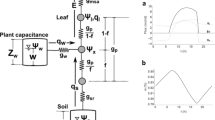Abstract
Water-storage capacity was measured inThuja occidentalis L.,Tsuga canadensis (L.) Carr., andAcer saccharum Marsh. during the dehydration of stem segments 1.5–2.5 cm in diameter. Stem water potential was measured with a temperature-corrected stem hygrometer and cavitations were detected acoustically. Water loss was measured by weight change. Dehydration isotherms consistently displayed three phases. The first phase, from water potential (Ψ) 0 to about −0.2 MPa, had a high capacitance (C>0.4kg water lost· (1 of tissue)−1· MPa−1) and we have attributed this high C to capillary water as defined by Zimmermann (1983, Xylem structure and the ascent of sap, Springer-Verlag). The second phase from Ψ=−0.5 to about −2.0 had the lowest C values (<0.02 kg·l−1·MPa−1) and was accompanied by a few cavitation events. This phase may have been a transition zone between capillary storage and water released by cavitation events as well as water drawn from living cells of the bark. The third phase also had a high C (about 0.07–0.22kg·l−1·MPa−1) and was associated with many cavitation events while Ψ declined below about −2.5 MPa; we presume the high capacitance was the consequence of water released by cavitation events. We discuss the ecological adaptive advantage of these three phases of water-storage in trees. In moist environments, water withdrawn from capillary storage may be an important fraction of transpiration, but may be of little adaptive advantage. For most of the growth season trees draw mainly on elastic storage, but stem elastic storage is less than leaf elastic storage and therefore unlikely to be important. In very dry environments, water relased by cavitation events might be important to the short-term survival of trees.
Similar content being viewed by others
Abbreviations
- AE:
-
acoustic emissions
- C:
-
capacitance
- Ψ:
-
water potential
References
Brough, D.W., Jones, H.G., Grace, J. (1986) Diurnal changes in water content of the stems of apple trees, as influenced by irrigation. Plant Cell Environ.9, 1–7
Dixon, M.A., Tyree, M.T. (1984) A new temperature corrected stem hygrometer and its calibration against the pressure bomb. Plant Cell Environ.7, 693–697
Edwards, W.R.N., Jarvis, P.G. (1982) Relation between water content, potential and permeability in stems of conifers. Plant Cell Environ.5, 271–277
Edwards, W.R.N., Jarvis, P.G. (1983) A method of measuring radial differences in water content of intact tree stems by attenuation of gamma radiation. Plant Cell Environ.6, 255–260
Edwards, W.R.N., Jarvis, P.G., Landsberg, J.J., Talbot, H. (1986) A dynamic model for studying flow of water in single trees. Tree Physiol.1, 309–324
Johnson, R.W., Tyree, M.T., Dixon, M.A. (1987) A requirement for sucrose in xylem sap flow from dormant maple trees. Plant Physiol.84, 495–500
Klepper, B., Browning, V.D., Taylor, H.M. (1971) Stem diameter in relation to plant water status. Plant Physiol.48, 683–685
Milburn, J.A., McLaughlin, M.E. (1974) Studies of cavitation in isolated vascular bundles and whole leaves ofPlantago major L. New Phytol.73, 861–871
Salleo, S., LoGullo, M.A. (1989) Xylem cavitation in nodes and internodes ofVitis, vinifera L. plants subjected to water stress. Limits of restoration of water conduction in cavitated xylem conduits. In: Structural and functional responses to environmental stress, pp. 33–42, Kreeb, K.H., Richter, H. Hinckley, T.M., eds. Academic Publishing, The Hague
Sperry, J.S., Tyree, M.T. (1988) Mechanism of water stress-induced xylem embolism. Plant Physiol.88, 581–587
Sperry, J.S., Holbrook, N.M., Zimmermann, M.H., Tyree, M.T. (1987) Spring filling of xylem vessels in grapevine. Plant Physiol.83, 414–417
Sperry, J.S., Donelly, J.R., Tyree, M.T. (1988) Seasonal occurrence of xylem embolism in sugar maple. (Acer saccharum). Am J. Bot.75, 1212–1218
Tyree, M.T. (1983) Maple sap uptake, exudation, and pressure changes correlated with freezing exotherms and thawing endotherms. Plant Physiol.73, 277–285
Tyree, M.T., Dixon, M.A. (1986) Water stress induced cavitation and embolism in some woody plants. Physiol. Plant66, 397–405
Tyree, M.T., Karamanos, A.J. (1980) Water stress as an ecological factor. In: Plants and their atmospheric environment, pp. 237–261, Grace, J., Ford, E.D., Jarvis, P.G., eds. Blackwells, Oxford, UK
Tyree, M.T., Sperry, J.S. (1989a) Vulnerability of xylem to cavitation and embolism. Annu. Rev. Plant Physiol. Mol. Biol.40, 19–38
Tyree, M.T., Sperry, J.S. (1989b) Characterization and propagation of acoustic emission signals in woody plants: towards an improved acoustic emission counter. Plant Cell Environ.12, 371–382
Tyree, M.T., Fiscus, E.L., Wullschleger, S.D., Dixon, M.A. (1986) Detection of xylem cavitation in corn under field conditions. Plant Physiol.82, 597–599
Waring, R.H., Running, S.W. (1978) Sapwood water-storage: its contribution to transpiration and effect upon water conductance through the stems of old-growth Douglas-fir. Plant Cell Environ.1, 1318140
Waring, R.H., Whitehead, D., Jarvis, P.G. (1979) The contribution of stored water to transpiration in Scots pine. Plant Cell Environ.2, 309–317
Zimmermann, M.H. (1983) Xylem structure and the ascent of sap. Springer, Berlin Heidelberg New York
Author information
Authors and Affiliations
Rights and permissions
About this article
Cite this article
Tyree, M.T., Yang, S. Water-storage capacity ofThuja, Tsuga andAcer stems measured by dehydration isotherms. Planta 182, 420–426 (1990). https://doi.org/10.1007/BF02411394
Received:
Accepted:
Issue Date:
DOI: https://doi.org/10.1007/BF02411394




